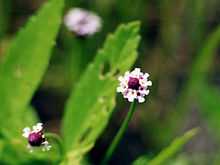Phyla lanceolata
| Phyla lanceolata | |
|---|---|
 | |
| Scientific classification | |
| Kingdom: | Plantae |
| (unranked): | Angiosperms |
| (unranked): | Eudicots |
| (unranked): | Asterids |
| Order: | Lamiales |
| Family: | Verbenaceae |
| Genus: | Phyla |
| Species: | P. lanceolata |
| Binomial name | |
| Phyla lanceolata (Michx.) Greene | |
| Synonyms | |
|
Lippia lanceolata | |
Phyla lanceolata is a species of flowering plant in the verbena family known by the common name lanceleaf fogfruit or frogfruit. It is native to the southern half of North America, including much of the United States except for the northwestern quadrant, and much of Mexico. It is resident in many types of moist and wet habitat, including disturbed areas, such as irrigation ditches. It is a perennial herb growing decumbent in a matlike form with spreading, trailing stems up to half a meter long, sometimes rooting at nodes. The lance-shaped or nearly oval leaves are up to 6 centimeters long and have toothed or partially toothed edges. The inflorescence, arising on a peduncle several centimeters tall, is a spherical spike of flowers which elongates into a cylindrical form as the fruits develop. The tiny, densely packed flowers are white, sometimes tinged with blue or purple.